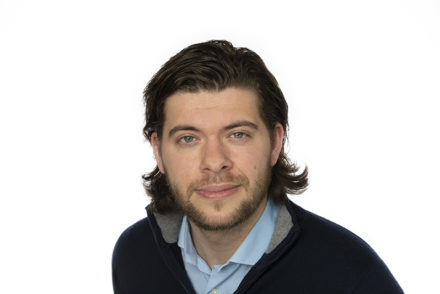Trying to rethink the f-word
On campus, failure has become the f-word we all try to avoid. A professor of innovation at Maastricht University is trying to change that. Paul Iske believes in the benefits of falling flat on your face – especially in science. “We need to rethink failure.”
With a PhD in theoretical physics, a prosperous career in business and a professorship at the University of Maastricht, Paul Iske has an impressive résumé. But his curriculum vitae doesn’t just list his successes. “My best failures are on there too”, he says.
Iske explains that he was inspired by Princeton professor Johannes Haushofer, who published a ‘CV of failures’ that listed the programs he did not get into, the grants he missed out on, the academic positions he did not get, and the rejections he received from scientific journals. Since then, Iske has made it a standard practice to list his most remarkable failures on his résumé. “I would advise every student to do the same. Take the failures you are most proud of, and put them on your CV. You’ll see that you will always be asked about them during a job interview.”
“Failure carries an enormous stigma, whether in business, in sports, or on campus”
Iske’s advice runs counter to the narrative we often hear on campus. After all, universities are designed to set students on the path to success. Messing up is not on the curriculum. “The problem is that people think of success as an outcome, not as a learning process”, Iske says. “Failure carries an enormous stigma, whether in business, in sports, or on campus.”
Failure-deprived students
At top universities in the United States – a country run by a president who divides the world into winners and losers – special programs are springing up to help students develop a more positive attitude towards failure. According to administrators at Harvard and Stanford University, today’s students have become ‘failure-deprived’. Because they are so focused on success and achievement, they don’t know how to fail anymore.
In order to help students overcome their fear of failure and to encourage them to take risks, Davidson College now has a Failure Fund, which awards grants to students who have creative and innovative ideas without asking them to demonstrate the viability of their proposed project. Harvard has launched an online Success-Failure Project, sharing rejection letters of deans, teachers, alums and students in an effort to normalize experiences of failure. And at Stanford, the Resilience Project aims to change the perception of failure from something that is shameful and undesirable, to something that has purpose and value.
Proof of incompetence
In our own country, the driving force behind the pro-failure movement is Paul Iske. He established the Institute of Brilliant Failures eight years ago, crowning himself Chief Failure Officer, in an attempt to change the way society thinks about failure. “Failure is often seen as proof of incompetence. In business, people who have experienced bankruptcy are viewed very negatively. They failed, so they must be stupid. That’s completely undeserved, since research has shown that business owners who start again after going through the experience of bankruptcy are often more successful than those who succeed the first time around.”
“Scientific progress often comes from trying things out”
In the academic world, failure comes in other forms. But the principle remains the same. Iske gives an example: “We should consider how we treat people who have worked on a failed research project. Do we write them off and exclude them from a new project, or do we bring them on board because they come with valuable experience?”
According to Iske, we learn by falling and getting back up again. And that’s particularly true for science. The willingness to risk failure is what makes science exciting and forever self-renewing, he explains. “Scientific progress often comes from trying things out. Uncertainties are an intrinsic part of science, but the pressure to reduce those uncertainties is enormous.”
Rat race
It’s not just students who struggle with fear of failure. For academics, especially those who are still relatively young and unestablished, failure can be a daunting and difficult experience that could have grave consequences. According to Iske, it’s a shame that the academic world has become ultra-focused on outcomes and results. In the end, the struggle for success could be damaging the very essence of science. “No matter how interesting or illuminating a research project is, it’s not considered publishable if there are no results to report. A lot of knowledge is lost that way. It simply never reaches the surface.”
Instead of asking the questions that matter, scientists will increasingly opt for asking the questions that will produce statistically significant results or that will get them a grant. “Just look at the way we deal with scientific publications”, Iske says. “Writing a research proposal is a time-consuming process, and the chances of getting funded are very slim. Academics have to spend a lot of time ‘selling’ their expected results to funding agencies before they can start doing actual research. PhD candidates walk around with stomach aches from worrying about their publication rates and citation indices. It has become a rat race. That’s undesirable, and it’s also unnecessary.”
“Universities should facilitate the possibility to try things, to start a research project, to explore an idea”
F the system
Paul Iske makes a strong case for the rethinking of failure on campus. “The academic world owes that to itself”, he convincingly argues. But the question remains: how? How do you make failure acceptable – and even laudable – within a community that has been frantically bleeping out the f-word for years and years?
“It’s very important that things change at an organizational level”, Iske says. “University boards and faculty deans need to create more space for what we call ‘agility’ in innovation science.” For example, academics should be able to work with a more go-with-the-flow approach, without stressing out about rigidly planned research objectives. “Universities should facilitate the possibility to try things, to start a research project, to explore an idea”, Iske explains. “At the same time, it should also be easier to stop when something is not working. In the current climate, it’s difficult to pull the plug on a research project once you’ve received funding for it. A change in incentives could encourage researchers to experiment, to take risks, to be open to the unexpected and to change course or to stop if needed, rather than dragging on some fixed four-year project that isn’t working.”
Brilliant failures
The main challenge is getting policy makers to take serious pro-failure actions. In the meantime, Paul Iske keeps saying the f-word loud and proud. Not just on campus, but in all areas of society. With his Institute of Brilliant Failures, Iske helps organizations create a more failure-friendly climate and gives lectures and speeches on the value of failures. He also hands out an award each year for the most brilliant failure in the field of healthcare.
Before you quit your job, burn your books and swap your laptop for a ukulele, you should know that not all failures all good. “Some failures are definitely more brilliant than others”, Iske says. Whether a failure classifies as brilliant, depends on several factors. “First of all, the intentions of your original goal must be solid. Secondly, your plan must be well-executed, which means you did all you can to avoid unnecessary mistakes. The third criterion, and this one is crucial in science, is that you learn something and that you’re willing to share that knowledge with others.”
Cars without roads
To illustrate what a brilliant failure looks like in practice, Iske shares one of his. “After my PhD, I started working for Shell. It was my task to improve the company’s knowledge management. There was a lot of knowledge at Shell, but it could be quite a hassle to find out what knowledge was located where within the organization. Internet was still very new at the time, and Google did not exist yet. I came up with the idea to build a search engine that allowed everyone within the company to look up which employee had the right expertise for which jobs. I interviewed four hundred employees, I wrote a profile of every one of them, and I also included a photo. Basically, I built LinkedIn.”
The online database was a great success, and Iske saw an opportunity. He quit his job at Shell and decided to offer his product to other organizations, convinced that he was about to make it big. What could possibly go wrong? But only two years later, Iske threw in the towel. “It was the 90s, most companies didn’t have intranet. They had no use for a professional social network”, he says. “After a while, I realized that I was building cars when there were no roads.”
Iske’s foreseen business empire never materialized. It turned out to be a failure. But it was a brilliant one. “It was a good idea, and it was well-executed. The timing just wasn’t right.”Paul Iske
Paul Iske is Professor Open Innovation and Business Venturing at the School of Business and Economics, Maastricht University. After his PhD in Theoretical Physics, he joined Shell focusing on research collaborations in the area of complex media. He founded his own company, aiming to commercialize the professional social network tool that he developed for Shell, but this failed. Then, he continued his career at ABN AMRO Bank, where he became Chief Dialogues Officer and Head of Innovation. He is founder and CFO (Chief Failure Officer) of the Institute of Brilliant Failures and Author, Speaker and Consultant in the areas of Innovation, Knowledge Management, Creativity and Entrepreneurship.







